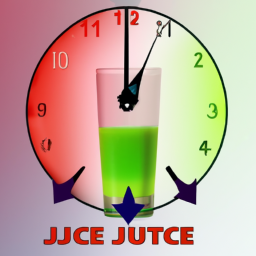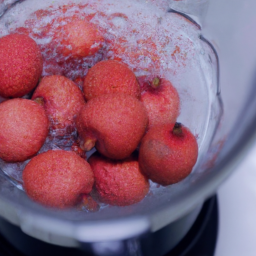As someone who loves juicing, I always wonder about the shelf life of fresh juice. Juicing requires a significant amount of time and effort, so it would be disappointing if the juice went bad too quickly.
I’ve done some research and learned that the shelf life of juice depends on a few factors, including the type of juicer you use, how you store the juice, and the ingredients you use.
In this article, I’ll discuss the different types of juicers and how they can affect the shelf life of your juice. I’ll also cover the signs of spoilage to look out for, how long fresh juice typically lasts, and tips for storing and extending the shelf life of your juice.
Whether you’re a seasoned juicer or just starting out, it’s important to understand how to keep your juice fresh and safe to drink.
Key Takeaways
- The shelf life of juice depends on factors such as the type of juicer used, storage temperature, exposure to air and light, and the type of produce used.
- Signs of spoiled juice include a sour or rancid smell and a darker or murky color.
- Different types of juice have varying shelf lives, with citrus juices lasting up to 2-3 days, green juices lasting 24-48 hours, and root vegetable juices lasting 3-4 days.
- To preserve juice freshness, it is important to choose the right container, refrigerate in the back of the fridge, avoid shaking the container, and clean the juicer properly after every use.
Types of Juicers
If you’re in the market for a juicer, it’s important to know the difference between a centrifugal and masticating juicer.
Centrifugal juicers are the most common type of juicer and are typically less expensive. These juicers work by using a fast-spinning blade to chop up the fruits and vegetables and then separate the juice from the pulp. They are quick and easy to use, making them a great option for busy individuals who want to make a quick glass of juice.
On the other hand, masticating juicers use a slower process to extract juice. They work by crushing the fruits and vegetables to extract the juice, which results in a higher yield of juice and less oxidation. While they are more expensive than centrifugal juicers, masticating juicers are quieter, produce less heat, and can be used to make nut butters, baby food, and even sorbets.
Manual and electric options are available for both centrifugal and masticating juicers, with manual options being less expensive and electric options being more convenient. When choosing a juicer, consider your lifestyle, budget, and desired features to determine which type of juicer is right for you.
When it comes to storing juice, the type of juicer you choose can affect the shelf life of your juice. Factors such as the temperature, exposure to light and air, and the type of container you use can also affect how long your juice will last.
Factors That Affect the Shelf Life
When it comes to the shelf life of fresh juice, there are several factors that can affect its quality and longevity.
As someone who regularly juices at home, I’ve learned that the type of ingredients used, storage temperature, and exposure to air and light are all critical considerations.
By understanding these factors, you can maximize the shelf life of your juice and ensure that it remains fresh and delicious for as long as possible.
Type of Ingredients
Typically, fresh juice made from fruits and vegetables can last for up to three days in your refrigerator, but it’s important to note that some ingredients, like citrus fruits, may cause the juice to spoil quicker due to their high acidity.
When juicing, it’s important to consider the type of ingredients you’re using and how they will affect the shelf life of your juice. Here are three things to keep in mind when it comes to ingredient selection:
- Choose hardy vegetables, like carrots and beets, that have a longer shelf life.
- Avoid using too many citrus fruits, as they can spoil the juice quickly.
- Add some acidic fruits, like apples or pineapples, to help preserve the juice.
By being mindful of the ingredients you use in your juice, you can help prolong its shelf life and ensure that it stays fresh for longer.
Now, let’s talk about how storage temperature can also affect the longevity of your juice.
Storage Temperature
Maintaining the perfect storage temperature for your freshly made juice is crucial to keep it crisp and refreshing for days. The optimal storage temperature for juice is between 32°F to 40°F. If you store your juice at a higher temperature, it can quickly spoil due to the growth of bacteria and yeast.
On the other hand, storing juice at a lower temperature can cause it to freeze, which can change its texture and flavor. Juicer maintenance is also essential when it comes to storing your juice. Before making juice, it’s essential to clean your juicer properly to prevent contamination.
A dirty juicer can contaminate your juice with bacteria and other harmful microorganisms, causing it to spoil more quickly. Proper cleaning and maintenance of your juicer can ensure that your juice stays fresh and tasty for longer.
As we move on to the subsequent section about exposure to air and light, it’s important to note that these factors can also have a significant impact on the shelf life of your juice.
Exposure to Air and Light
Did you know that exposure to air and light can impact the freshness and taste of your juice? Oxygen and UV rays can cause oxidation and nutrient loss, leading to a decline in quality. That’s why it’s crucial to store your juice in airtight containers and keep it away from direct sunlight.
Here are some other ways packaging can affect juice preservation:
- Dark-colored bottles or containers can help protect your juice from UV light.
- Vacuum-sealed packaging can extend the shelf life of your juice.
- Glass containers are better than plastic ones, as they don’t react with the juice and don’t leach any harmful chemicals.
- Using a juicer with a slow extraction process can help preserve the nutrients and enzymes in your juice.
It’s important to pay attention to the packaging and storage of your juice to ensure that it stays fresh and retains its nutritional value. However, even with proper storage, signs of spoilage may still occur.
Let’s take a look at some of the indicators of a juice that has gone bad.
Signs of Spoilage
You can easily tell if your freshly squeezed juice has gone bad by checking for any unusual odor or change in color. Spoiled juice may have a sour or rancid smell, and its color may become darker or murky. If you notice any of these signs, it’s best to discard the juice as soon as possible.
Consuming spoiled juice can result in various health risks, including food poisoning, stomach upset, and diarrhea. It’s not recommended to use spoiled juice in any way, as it may contain harmful bacteria that can cause illness.
To avoid consuming spoiled juice, it’s important to store it properly and consume it within its recommended shelf life.
In the next section, we’ll discuss how long fresh juice lasts and the best ways to store it to ensure its freshness.
How Long Does Fresh Juice Last?
When I make fresh juice using my juicer, I always wonder how long it will last before it spoils. The shelf life of different types of juice can vary depending on various factors, such as the type of fruit or vegetable used, the storage temperature, and the presence of preservatives.
In this discussion, I’ll explore these factors and provide evidence-based information on the shelf life of different types of fresh juice.
Shelf Life of Different Types of Juice
The shelf life of fresh juice varies depending on the type of fruit or vegetable used in the juicing process. Here are some examples:
-
Citrus juices (such as orange and grapefruit) can last up to 2-3 days when stored in the refrigerator. To extend their freshness, try adding a small amount of lemon juice or vitamin C powder to the juice before storing.
-
Green juices (such as kale and spinach) have a shorter shelf life of 24-48 hours. To preserve their nutrients and freshness, store them in airtight containers and avoid exposing them to light and air.
-
Root vegetable juices (such as carrot and beet) can last up to 3-4 days when refrigerated. To extend their shelf life, add a small amount of lemon juice or apple cider vinegar to the juice and store in a glass container.
Factors that affect the shelf life of fresh juice include the type of produce used, the juicing method, and storage conditions. By understanding how long different types of juices can last and applying juice preservation techniques, you can enjoy the benefits of freshly made juice for longer.
Factors That Affect the Shelf Life
Like a delicate flower, the shelf life of fresh juice is affected by various factors such as the type of produce used, juicing method, and storage conditions. These factors are crucial in determining the quality and freshness of the juice. For instance, the type of produce used can impact the shelf life of the juice. Citrus fruits, for example, have a shorter shelf life than vegetables such as kale or spinach. This is because citrus fruits have a higher sugar content, which makes them more prone to spoilage.
Another factor that affects the shelf life of fresh juice is the juicing method. Cold press juicers, for instance, produce juice that lasts longer than juice made from centrifugal juicers. The reason is that cold press juicers extract juice by pressing the fruits or vegetables, which minimizes the amount of air and heat introduced to the juice. On the other hand, centrifugal juicers use a spinning blade to extract juice, which introduces air and heat, leading to oxidation and a shorter shelf life. Finally, storage conditions such as temperature, light, and oxygen exposure also affect the freshness of the juice. A good rule of thumb is to store the juice in an airtight container in the fridge, away from direct sunlight and heat sources.
Factors affecting juice quality and preserving juice freshness are crucial in ensuring that the juice remains fresh and of high quality. Understanding these factors can help you make informed decisions when preparing or buying fresh juice. In the next section, we will explore how to store fresh juice to maximize its shelf life and retain its freshness.
How to Store Fresh Juice
When it comes to storing fresh juice, there are a few key points to keep in mind. First, choosing the right container is essential to preserving the flavor and nutrients of the juice.
Second, refrigeration is important for maintaining freshness and preventing bacterial growth. And finally, freezing can be a great option for extending the shelf life of your juice.
As someone who regularly juices, I’ve found that following these guidelines helps me get the most out of my fresh juice.
Choosing the Right Container
Opt for an airtight container to store your freshly squeezed juice and extend its shelf life. When choosing the right container for your juice, there are several factors to consider, such as glass versus plastic and airtight versus breathable. Glass containers are often preferred because they are non-reactive and do not contain harmful chemicals that can leach into the juice. Plastic containers, on the other hand, can be convenient because they are lightweight and less likely to break. However, it’s important to choose a food-grade plastic that is free of BPA and other harmful chemicals.
In addition to the material of the container, it’s important to choose one that is airtight. This helps to prevent oxidation and keep the juice fresh for longer. Airtight containers can be made of glass or plastic and typically have a secure lid that seals tightly. On the other hand, breathable containers, such as those with holes or mesh, are not recommended for storing juice as they can allow air and bacteria to enter, causing the juice to spoil more quickly. Once you have chosen the right container, it’s important to refrigerate the juice promptly to further extend its shelf life.
Refrigeration
It’s essential to keep your freshly squeezed beverage cool in the fridge to preserve its freshness and prevent spoilage. Proper juice storage can help maintain the nutrients and flavors of your juice for up to 72 hours.
Here are some tips on how to preserve the freshness of your juice:
-
Use airtight containers: Oxygen can cause the juice to deteriorate quickly, so it’s important to store it in airtight containers. Mason jars, glass bottles, and plastic containers with tight-fitting lids are good options.
-
Store in the back of the fridge: The back of the fridge is the coldest part, and is ideal for storing your juice. Avoid storing juice in the refrigerator door, as the temperature fluctuates too much.
-
Don’t shake the container: Shaking the container can cause air bubbles to form, which can affect the quality of your juice. Instead, gently stir the juice before serving.
Now that you know how to properly store your juice, let’s talk about freezing it for longer storage.
Freezing
To extend the shelf life of your freshly squeezed beverage, you can freeze it in ice cube trays or freezer-safe containers. Freezing your juice is a great way to preserve its nutrients and flavor for a longer period of time.
You can use different freezing techniques depending on your preference and storage space. One way to freeze your juice is to pour it into ice cube trays and let it freeze completely. Once frozen, you can transfer the juice cubes into a freezer-safe container and keep them frozen until you’re ready to use them.
Another way is to pour the juice into a freezer-safe container and leave some room for expansion during the freezing process. Make sure to label the container with the date and type of juice to keep track of its freshness. When thawing your frozen juice, you can either let it sit in the refrigerator overnight or place it in a bowl of warm water until it reaches room temperature.
To extend the shelf life of your juice, there are other tips you can follow such as adding lemon juice to increase its acidity and prevent spoilage, using airtight containers to prevent freezer burn, and storing it in the back of the freezer where the temperature is more consistent. By following these tips, you can enjoy your freshly squeezed juice for a longer period of time.
Tips to Extend the Shelf Life
If you want your juice from the juicer to last longer, you should store it in an airtight container in the fridge. Here are some ways to preserve freshness and prevent spoilage:
-
Use glass containers instead of plastic as they’re less porous and won’t interact with the juice.
-
Fill the container to the brim to minimize air exposure.
-
Add a squeeze of lemon or lime to the juice as they’re natural preservatives.
-
Freeze some of the juice in ice cube trays and add them to your next batch for added freshness.
-
Don’t mix different types of juice together as this can cause spoilage.
By following these tips, you can extend the shelf life of your juice from the juicer and enjoy it for a longer period of time.
Now, let’s move on to the next section about best practices for cleaning your juicer.
Best Practices for Cleaning Your Juicer
Now that we’ve learned about some tips to extend the shelf life of juiced fruits and vegetables, let’s talk about the importance of cleaning your juicer.
A clean juicer not only ensures that your juice is free from harmful bacteria and contaminants, but it also helps prolong the life of your juicer.
Cleaning techniques may vary depending on the type of juicer you have, but it’s recommended to clean your juicer after every use.
To clean your juicer, start by unplugging it and disassembling all the removable parts. Rinse each part with warm water and use a soft-bristled brush to scrub away any leftover pulp or residue.
For tougher stains, you can use a mixture of baking soda and water or a recommended cleaning product. Once all the parts are clean, rinse them thoroughly and let them air dry before reassembling the juicer.
When it comes to cleaning products, it’s important to use only those that are recommended by the manufacturer. Using harsh chemicals or abrasive materials can damage the juicer and void its warranty.
Some juicer manufacturers also offer their own cleaning products that are specifically designed to clean their juicers.
By following these cleaning practices, you can ensure that your juicer stays in top condition and that you’re enjoying safe and healthy juice.
As we’ve discussed the importance of cleaning your juicer, the next step is to ensure that you’re practicing proper juicing safety tips.
Juicing Safety Tips
Ensuring your safety while juicing is like wearing a seatbelt when driving – it’s an essential precaution to take. One of the most important things to keep in mind when juicing is proper juicing hygiene.
This means that you need to wash your produce thoroughly before adding it to the juicer. This will help remove any dirt, bacteria, or other contaminants that could make you sick. In addition, make sure you clean your juicer properly after each use to avoid any build-up of bacteria or mold.
Another important aspect of juicing safety is to use the proper equipment. Always use a juicer that is specifically designed for juicing and follow the manufacturer’s instructions carefully. Using the wrong equipment or not following the instructions can result in injury or damage to your juicer. Additionally, make sure that all of your equipment is in good working order before using it.
This will help ensure that your juicing experience is safe and enjoyable. With these safety tips in mind, you can enjoy the benefits of freshly made juice without any worries. Juicing is a great way to get all of the nutrients and vitamins your body needs in one delicious drink.
In the next section, we’ll explore some of the amazing benefits of freshly made juice.
Benefits of Freshly Made Juice
Imagine how amazing you’ll feel after incorporating freshly made juice into your daily routine. Packed with essential vitamins and nutrients, it’s a refreshing way to boost your health and energy levels.
Not only is juice delicious and enjoyable to drink, but it also offers numerous nutritional benefits that can help improve your overall health. One of the biggest health advantages of fresh juice is that it is a concentrated source of vitamins, minerals, and other essential nutrients.
This means that you can consume a large amount of nutrients in a single glass of juice, helping you to meet your daily recommended intake of vitamins and minerals. Additionally, because the juice is freshly made, it retains all of its nutrients and enzymes, ensuring that you get the full nutritional benefits.
So, if you’re looking for a tasty and healthy way to boost your health, incorporating freshly made juice into your daily routine is definitely worth considering.
Frequently Asked Questions
Can juice from a juicer be frozen to extend its shelf life?
I’ve found that juice freezing can extend its shelf life up to 8 months. To ensure quality, use air-tight containers or freezer bags, leaving a bit of space for expansion. Glass or BPA-free plastic are the best options.
Is it safe to consume juice from a juicer that has been left out overnight?
It is not safe to consume juice from a juicer that has been left out overnight due to the risk of bacterial growth. Juice safety is important to prevent illness. Always refrigerate juice promptly after juicing.
Are there any specific fruits or vegetables that have a shorter or longer shelf life when juiced?
When considering Fruit & Vegetable Shelf Life, it’s important to know that some produce will oxidize quicker than others when juiced. To maximize freshness, store juice in an airtight container and consume within 24 hours. Juicing Tips: Use fresh, high-quality produce and clean your juicer thoroughly after each use.
Can juicers be used to make smoothies or other blended drinks?
Yes, juicers can be used to make smoothies and other blended drinks by adding additional ingredients. However, the benefits of juicing over blending include higher nutrient density and easier digestion. Check online for juicer smoothie recipes.
How often should the juicer be cleaned to ensure optimal freshness and quality of the juice?
I’ve found that cleaning my juicer after every use keeps the juice fresh for up to 24 hours. Frequent cleaning prevents buildup and oxidation, ensuring optimal freshness. It’s worth the effort for a better tasting, healthier juice.
Conclusion
Overall, the shelf life of juice from a juicer depends on a variety of factors, including the type of juicer used, the ingredients used, and how the juice is stored. It’s important to pay attention to signs of spoilage, such as changes in color, texture, or taste, to ensure that your juice is still safe to consume.
To extend the shelf life of your fresh juice, consider using a slow juicer, storing the juice in an airtight container, and consuming it within 24-48 hours. Additionally, make sure to clean your juicer thoroughly after each use to prevent bacterial growth and maintain the quality of your juice.
By following these tips and best practices, you can enjoy the benefits of freshly made juice with minimal risk of spoilage or contamination. As the saying goes, "an apple a day keeps the doctor away."With a juicer, you can enjoy the benefits of multiple fruits and vegetables in one delicious and nutritious drink.
Ilana has been a vegan for over 10 years. She originally made the switch for health reasons, but soon found herself becoming more and more passionate about the ethical and environmental implications of a vegan lifestyle. Ilana is the author of The Graceful Kitchen, a blog all about veganism. She loves to cook up delicious and nutritious vegan meals, and share her recipes with others who are interested in leading a cruelty-free life. Ilana is also a strong advocate for using whole foods as the foundation of a healthy diet, and believes that going vegan is one of the best ways to achieve this.










